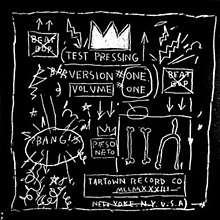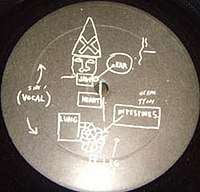Beat Bop
"Beat Bop" is a single by American hip-hop artists Rammellzee and K-Rob, originally released in 1983 by record label Tartown. It was initially distributed merely as a test pressing. Its cover was designed by New York City graffiti artist Jean-Michel Basquiat. The result of a disagreement between Rammellzee and Basquiat, the track has been cited as having an influence on artists such as Beastie Boys and many hip hop artists due to its chaotic, abstract sound.
| "Beat Bop" | |
|---|---|
 | |
| Single by Rammellzee and K-Rob | |
| B-side | "Beat Bop (Instrumental)" |
| Released | 1983 |
| Length | 10:10 |
| Label | Tartown/Profile Records |
| Songwriter(s) | Rammellzee, K-Rob |
| Producer(s) | Jean-Michel Basquiat |
Due to the rarity of its original pressing, it has been called the Holy Grail of rap records.[1] It is featured in the hip-hop documentary film Style Wars.
Background and recording
The track was initially intended as a battle rap between Rammellzee and Basquiat, following heated arguments between the two.[2] Rammellzee, an influential graffiti artist himself, accused Basquiat of being a fraud. In turn, Basquiat claimed he could out-rap, out-dance, and out-paint anybody.[3] The duo eventually settled on "Beat Bop" acting as an outlet for this tension. With links to Andy Warhol, Jean-Michel Basquiat was the toast of the New York art world during that period. Rammellzee, on the other hand, describes himself as being an "up-and-coming con artist". Basquiat therefore agreed to pay for recording, pressing and eventual release. Despite this, both Rammellzee and K-Rob had the power to overrule Basquiat on the record's content:
"He wanted [to] say his own verses... me and K-Rob read them and started laughing, and we crushed up his paper with the words he had written down and we threw it back at him face first."[4]
The result was a ten-minute track featuring Rammellzee and K-Rob on vocals, under the direction of Fab Five Freddy,[5] its production credited to Basquiat only (despite Rammellzee insisting that Basquiat did nothing but foot the bill). Speaking in 2008, Rammellzee reflected on the relaxed nature of the recording session by saying "we were just having fun".[4] The record was eventually released in 1983, limited to 500 copies with custom art by Basquiat. It has also been distributed by Profile Records, in 1983 and later in 2001.
Composition
The theme for Style Wars, a documentary film that focuses on graffiti and other areas of hip hop culture, "Beat Bop" is largely typical of early 1980s New York hip hop music. However, the track has experimental touches that have led it to be described as "both hip hop's artiest and its rootsiest record"[6] and "one of the craziest records of all time".[4] Similarly, Internet record store Boomkat praises the record, describing it as "a stunning ten minutes of psychedelic instruments and stunning old school anthem lyrics".[2] Over ten minutes long, with no definite chorus or structure, the track is epic in scope, featuring a driving bassline that underpins the track and a heavy influence from both disco and funk. Various instruments are brought in and out of the mix throughout, the majority of them played by Al Diaz, a friend of Basquiat.[7] These include a violin, an electric guitar, and a varied range of percussion. The vocals are delivered in a relaxed, chaotic and almost stream of consciousness manner, often overlapping themselves, with both rappers occasionally adopting fake voices. A heavy amount of reverb is applied to the vocals in a seemingly random manner, sometimes during the middle of sentences. The track ends by fading out during the middle of a verse, offering the listener no definite conclusion. Each version of the single has featured the instrumental of the track on the B-side.
The lyrics take the form of improvised role playing, with Rammellzee playing a pimp and K-Rob in the character of a schoolboy. Rammellzee's vocal delivery has been cited by Allmusic as a clear example of his "flights of wordplay, fantasy, and street surrealism".[8] The lyrical abstraction present on "Beat Bop" is often praised; writing for The Guardian, Chris Campion commented that "people have been trying to decipher it ever since".[9]
Legacy
Rammellzee revealed in a 2008 interview[4] that he saw the single as "just simply a test pressing" and that he had no specific expectations. However, he admitted that its surprise success changed the direction of his life, allowing him to tour around the world instead of being a dentist as he originally intended. The single has sold more than 150,000 copies, though Rammellzee insists that he has received no money from it. On his 2004 debut full-length release, Bi-Conicals of the Rammellzee, Rammellzee reunited with K-Rob to record "Beat Bop Part 2". Though K-Rob was now a "full fledged Muslim", devoting his time to prayers and preaching rather than music, Rammellzee was happy with the result: "I thought it was fantastic the second time around... this time me and K-Rob were doing fine without crushing up papers and being stalled by a person who wanted things to be done his way." "Beat Bop Part 2" is a decidedly retrospective track, a throwback to early 1980s rap, with Rammellzee commenting in its first verse: "I know it's been a while since you heard me rap, but I had to bring it back since the shit got wack."
Having performed with many groups, most notably Gettovetts and Death Comet Crew, as well as releasing solo material, Rammellzee remained the most musically active of the three artists involved in "Beat Bop" following its release. Over the next two decades he also developed his complex "gothic futurism" philosophy, which is detailed on his website of the same name. Rammellzee died in 2010, at the age of 49.[10] K-Rob would continue to release singles until 1986, most famously "I'm a Homeboy" with production by Duke Bootee and scratches by DJ Cheese.[11] However, "Beat Bop" remains Basquiat's most notable foray into music creation (he also appeared in the video for Blondie's "Rapture"); he decided instead to continue focusing on painting, exhibiting his work around the world to great acclaim until his death in 1988.
The single has been described as a blueprint for the "apocalyptic, witty, and experimental" style of many modern hip hop artists, such as Antipop Consortium and El-P.[12] The track has even been thought to provide a stylistic basis for more famous groups, such as Cypress Hill and Beastie Boys.[7] Influential British DJ Tim Westwood is known to have been a big fan of the track.[13] It has been cited as one of the essential records of old school hip hop, alongside more popular tracks like "Rapper's Delight" and "The Message", with one writer calling it "the Ulysses of rap music".[3]

Cover art
Designed solely by Jean-Michel Basquiat, the artwork of the record are typical of his style, featuring a graffiti-influenced, chaotic clash of imagery and text. In contrast to his colourful canvas work, however, they are drawn in black and white. The front cover includes rough sketches of bones, what appears to be a crown, an explosion (and within it, the word "bang!" in capital letters), and Roman numerals. The record labels are in the same style, even going as far as originally not mentioning the artists involved in its production or the name of the track.[14] Due to Basquiat's fame, original copies exchange hands for over four figures.[4] Curiously, the cover spells Rammellzee's name incorrectly, using only one L instead of two, a fact that irked Rammellzee even in the years following the record's release. The single was repressed in 2001 by Tartown Records, the label that initially released it, with its original cover art retained.[15]
Personnel
- Vocals – Rammellzee, K-Rob
- Production – Jean-Michel Basquiat
- Percussion – Al Diaz
References
- "Rammellzee vs. K-Rob – Beat Bop (12") at Discogs". Discogs. Archived from the original on February 6, 2010. Retrieved December 24, 2009.
- "RAMELZEE & K ROB, Beat Bop – Boomkat". Boomkat. April 24, 2008. Archived from the original on February 6, 2010. Retrieved December 24, 2009.
- "10 Essential Cuts from Old School Hip Hop". JamsBio Magazine. January 23, 2009. Archived from the original on February 6, 2010. Retrieved January 6, 2010.
- "BLUNT RAPS >> Rammellzee Interview". Cocaine Blunts. April 24, 2008. Archived from the original on February 6, 2010. Retrieved 24 December 2009.
- "Jean-Michel Basquiat's Beat Bop recording – New Music". Lost At E Minor. Lost At E Minor: For creative people. July 31, 2009. Archived from the original on February 6, 2010. Retrieved December 24, 2009.
- "WOEBOT: The 100 Greatest Records Ever". Woebot. December 28, 2005. Archived from the original on February 6, 2010. Retrieved December 24, 2009.
- "Tangents fun'n'frenzy filled web site". Tangents. 2002. Archived from the original on February 6, 2010. Retrieved December 24, 2009.
- "allmusic ((( Rammellzee > Biography )))". Allmusic. December 28, 2005. Archived from the original on February 6, 2010. Retrieved December 24, 2009.
- Campion, Chris (December 28, 2005). "The Rammellzee: Bi-Conicals of the RammEllZee". The Guardian. Archived from the original on February 6, 2010. Retrieved December 24, 2009.
- Weiss, Jeff (July 1, 2010). "R.I.P. Rammellzee: The original abstract-rapping outlaw". Los Angeles Times. Archived from the original on July 2, 2010. Retrieved July 3, 2010.
- "OldSchoolHipHop.Com – K Rob Biography". OldSchoolHipHop.Com. October 23, 2007. Archived from the original on February 6, 2010. Retrieved January 7, 2010.
- "The Rammellzee: Bi-Conicals of the Rammellzee – Pop Matters Music Review". Pop Matters. April 24, 2008. Archived from the original on February 6, 2010. Retrieved December 24, 2009.
- "Rammelzee". Stone Cold Breaks. December 21, 2009. Archived from the original on February 6, 2010. Retrieved January 6, 2010.
- "Images for Rammellzee vs. K-Rob – Beat Bop". Discogs. Archived from the original on February 6, 2010. Retrieved January 1, 2010.
- "Rammelzee* Versus K.Rob* – Beat Bop (12", RP) at Discogs". Discogs. Archived from the original on February 6, 2010. Retrieved January 1, 2010.